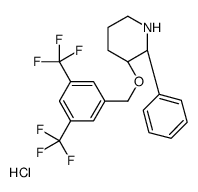L-733,060 hydrochloride
Modify Date: 2024-01-11 17:39:19

L-733,060 hydrochloride structure
|
Common Name | L-733,060 hydrochloride | ||
|---|---|---|---|---|
| CAS Number | 148687-76-7 | Molecular Weight | 439.82200 | |
| Density | N/A | Boiling Point | N/A | |
| Molecular Formula | C20H20ClF6NO | Melting Point | N/A | |
| MSDS | Chinese | Flash Point | N/A | |
Use of L-733,060 hydrochlorideL-733060 hydrochloride is a potent tachykinin NK1 receptor antagonist. L-733060 hydrochloride inhibits neurogenic plasma extravasation at doses that do not cause adverse cardiovascular effects in rodents and also acts as an antitumoral agent[1][2]. |
| Name | (2R,3R)-3-[[3,5-bis(trifluoromethyl)phenyl]methoxy]-2-phenylpiperidine,hydrochloride |
|---|---|
| Synonym | More Synonyms |
| Description | L-733060 hydrochloride is a potent tachykinin NK1 receptor antagonist. L-733060 hydrochloride inhibits neurogenic plasma extravasation at doses that do not cause adverse cardiovascular effects in rodents and also acts as an antitumoral agent[1][2]. |
|---|---|
| Related Catalog | |
| Target |
NK1 |
| In Vitro | L-733060 (30-300 nM) inhibits the [Ca2+]i mobilisation caused by substance P (100 nM) in a concentration-dependent manner in human tachykinin NK1 receptor-transfected CHO cells[1]. L-733060 (2.5-20 μM; 48 and or 96 h) results in a concentration-dependent cytotoxicity in COLO 858 cells[2]. L-733060 (10-30 μM; 24 and 48 h) inhibits MEL H0 cells proliferation with IC50s of 27.5 μM and 18.9 μM at 24 h and 48 h, respectively[2]. L-733060 (20-50 μM; and or 72 h) inhibits COLO 679 cells growth with IC50s of 33.8 μM and 31.5 μM at 30 h and 72 h, respectively[2]. Cell Proliferation Assay[2] Cell Line: COLO 858 cells Concentration: 2.5, 5, 10, 20 μM Incubation Time: 0, 48, 96 h Result: Inhibited cells growth with IC50s of 8.7 μM and 7.1 μM at 48 h and 96 h, respectively. |
| In Vivo | L-733060 (10-1000 μg/kg; i.v.) inhibits electrically stimulated plasma extravasation in dura mater of rats[1]. L-733060 (300-3000 μg/kg; i.v.) has no significant hypotensive or bradycardic effects are observed at doses of <3000 μg/kg in conscious or anaesthetised rats[1]. Animal Model: Male Sprague-Dawley rats (200 g) with electrical stimulation of the trigeminal ganglion[1] Dosage: 10, 100, 1000 mg/kg Administration: I.v. injection Result: Produced a significant dose-related inhibition of plasma extravasation with an ID50 of 212±19 μg/kg. |
| References |
| Molecular Formula | C20H20ClF6NO |
|---|---|
| Molecular Weight | 439.82200 |
| Exact Mass | 439.11400 |
| PSA | 21.26000 |
| LogP | 6.86490 |
| Safety Phrases | 22-24/25 |
|---|---|
| WGK Germany | 3 |
| L-733,060 hydrochloride |
| (2S,3S)-3-[(3,5-bis(Trifluoromethyl)phenyl)methoxy]-2-phenylpiperidine hydrochloride |
| L-733,061 hydrochloride |
| L-733060 hydrochloride |